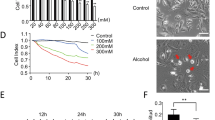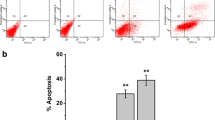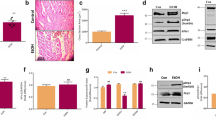Abstract
Abusive chronic alcohol consumption can cause metabolic and functional derangements in the heart and is a risk factor for development of non-ischemic cardiomyopathy. microRNA 214 (miR-214) is a molecular sensor of stress signals that negatively impacts cell survival. Considering cardioprotective and microRNA modulatory effects of sildenafil, a phosphodiesterase 5 (PDE5) inhibitor, we investigated the impact of chronic alcohol consumption on cardiac expression of miR-214 and its anti-apoptotic protein target, Bcl-2 and whether sildenafil attenuates such changes. Adult male FVB mice received unlimited access to either normal liquid diet (control), alcohol diet (35% daily calories intake), or alcohol + sildenafil (1 mg/kg/day, p.o.) for 14 weeks (n = 6–7/group). The alcohol-fed groups with or without sildenafil had increased total diet consumption and lower body weight as compared with controls. Echocardiography-assessed left ventricular function was unaltered by 14-week alcohol intake. Alcohol-fed group had 2.6-fold increase in miR-214 and significant decrease in Bcl-2 expression, along with enhanced phosphorylation of ERK1/2 and cleavage of PARP (marker of apoptotic DNA damage) in the heart. Co-ingestion with sildenafil blunted the alcohol-induced increase in miR-214, ERK1/2 phosphorylation, and maintained Bcl-2 and decreased PARP cleavage levels. In conclusion, chronic alcohol consumption triggers miR-214-mediated pro-apoptotic signaling in the heart, which was prevented by co-treatment with sildenafil. Thus, PDE5 inhibition may serve as a novel protective strategy against cardiac apoptosis due to chronic alcohol abuse.







Similar content being viewed by others
References
Manthey J, Shield KD, Rylett M, Hasan OSM, Probst C, Rehm J (2019) Global alcohol exposure between 1990 and 2017 and forecasts until 2030: a modelling study. Lancet 393(10190):2493–2502. https://doi.org/10.1016/S0140-6736(18)32744-2
Fauchier L, Babuty D, Poret P, Casset-Senon D, Autret ML, Cosnay P et al (2000) Comparison of long-term outcome of alcoholic and idiopathic dilated cardiomyopathy. Eur Heart J 21(4):306–314. https://doi.org/10.1053/euhj.1999.1761
Preedy VR, Patel VB, Reilly ME, Richardson PJ, Falkous G, Mantle D (1999) Oxidants, antioxidants and alcohol: implications for skeletal and cardiac muscle. Front Biosci 4:e58–e66
Urbano-Marquez A, Estruch R, Navarro-Lopez F, Grau JM, Mont L, Rubin E (1989) The effects of alcoholism on skeletal and cardiac muscle. N Engl J Med 320(7):409–415. https://doi.org/10.1056/NEJM198902163200701
Mathews EC Jr, Gardin JM, Henry WL, Del Negro AA, Fletcher RD, Snow JA et al (1981) Echocardiographic abnormalities in chronic alcoholics with and without overt congestive heart failure. Am J Cardiol 47(3):570–578
Lazarevic AM, Nakatani S, Neskovic AN, Marinkovic J, Yasumura Y, Stojicic D et al (2000) Early changes in left ventricular function in chronic asymptomatic alcoholics: relation to the duration of heavy drinking. J Am Coll Cardiol 35(6):1599–1606
Zhang X, Li SY, Brown RA, Ren J (2004) Ethanol and acetaldehyde in alcoholic cardiomyopathy: from bad to ugly en route to oxidative stress. Alcohol 32(3):175–186. https://doi.org/10.1016/j.alcohol.2004.01.005
Laurent D, Mathew JE, Mitry M, Taft M, Force A, Edwards JG (2014) Chronic ethanol consumption increases myocardial mitochondrial DNA mutations: a potential contribution by mitochondrial topoisomerases. Alcohol Alcohol 49(4):381–389. https://doi.org/10.1093/alcalc/agu029
Capasso JM, Li P, Guideri G, Malhotra A, Cortese R, Anversa P (1992) Myocardial mechanical, biochemical, and structural alterations induced by chronic ethanol ingestion in rats. Circ Res 71(2):346–356
Tan Y, Li X, Prabhu SD, Brittian KR, Chen Q, Yin X et al (2012) Angiotensin II plays a critical role in alcohol-induced cardiac nitrative damage, cell death, remodeling, and cardiomyopathy in a protein kinase C/nicotinamide adenine dinucleotide phosphate oxidase-dependent manner. J Am Coll Cardiol 59(16):1477–1486. https://doi.org/10.1016/j.jacc.2011.12.034
Zhao Y, Ponnusamy M, Zhang L, Zhang Y, Liu C, Yu W et al (2017) The role of miR-214 in cardiovascular diseases. Eur J Pharmacol 816:138–145. https://doi.org/10.1016/j.ejphar.2017.08.009
Hou Y, Sun Y, Shan H, Li X, Zhang M, Zhou X et al (2012) beta-adrenoceptor regulates miRNA expression in rat heart. Med Sci Monit 18(8):BR309–BR314. https://doi.org/10.12659/msm.883263
Yang T, Zhang GF, Chen XF, Gu HH, Fu SZ, Xu HF et al (2013) MicroRNA-214 provokes cardiac hypertrophy via repression of EZH2. Biochem Biophys Res Commun 436(4):578–584. https://doi.org/10.1016/j.bbrc.2013.05.079
Katoh M (2014) Cardio-miRNAs and onco-miRNAs: circulating miRNA-based diagnostics for non-cancerous and cancerous diseases. Front Cell Dev Biol 2:61. https://doi.org/10.3389/fcell.2014.00061
Lu HQ, Liang C, He ZQ, Fan M, Wu ZG (2013) Circulating miR-214 is associated with the severity of coronary artery disease. J Geriatr Cardiol 10(1):34–38. https://doi.org/10.3969/j.issn.1671-5411.2013.01.007
Sharma T, Hamilton R, Mandal CC (2015) miR-214: a potential biomarker and therapeutic for different cancers. Future Oncol 11(2):349–363. https://doi.org/10.2217/fon.14.193
Park KM, Teoh JP, Wang Y, Broskova Z, Bayoumi AS, Tang Y et al (2016) Carvedilol-responsive microRNAs, miR-199a-3p and -214 protect cardiomyocytes from simulated ischemia-reperfusion injury. Am J Physiol Heart Circ Physiol 311(2):H371–H383. https://doi.org/10.1152/ajpheart.00807.2015
Wang X, Ha T, Hu Y, Lu C, Liu L, Zhang X et al (2016) MicroRNA-214 protects against hypoxia/reoxygenation induced cell damage and myocardial ischemia/reperfusion injury via suppression of PTEN and Bim1 expression. Oncotarget 7(52):86926–86936. https://doi.org/10.18632/oncotarget.13494
Liu LQ, Fan ZQ, Tang YF, Ke ZJ (2014) The resveratrol attenuates ethanol-induced hepatocyte apoptosis via inhibiting ER-related caspase-12 activation and PDE activity in vitro. Alcohol Clin Exp Res 38(3):683–693. https://doi.org/10.1111/acer.12311
Shalwala M, Zhu SG, Das A, Salloum FN, Xi L, Kukreja RC (2014) Sirtuin 1 (SIRT1) activation mediates sildenafil induced delayed cardioprotection against ischemia-reperfusion injury in mice. PLoS ONE 9(1):e86977. https://doi.org/10.1371/journal.pone.0086977
Das A, Xi L, Kukreja RC (2005) Phosphodiesterase-5 inhibitor sildenafil preconditions adult cardiac myocytes against necrosis and apoptosis. Essential role of nitric oxide signaling. J Biol Chem. 280(13):12944–12955. https://doi.org/10.1074/jbc.M404706200
Das A, Xi L, Kukreja RC (2008) Protein kinase G-dependent cardioprotective mechanism of phosphodiesterase-5 inhibition involves phosphorylation of ERK and GSK3beta. J Biol Chem 283(43):29572–29585. https://doi.org/10.1074/jbc.M801547200
Ockaili R, Salloum F, Hawkins J, Kukreja RC (2002) Sildenafil (Viagra) induces powerful cardioprotective effect via opening of mitochondrial K(ATP) channels in rabbits. Am J Physiol Heart Circ Physiol 283(3):H1263–H1269. https://doi.org/10.1152/ajpheart.00324.2002
Salloum F, Yin C, Xi L, Kukreja RC (2003) Sildenafil induces delayed preconditioning through inducible nitric oxide synthase-dependent pathway in mouse heart. Circ Res 92(6):595–597. https://doi.org/10.1161/01.RES.0000066853.09821.98
Fisher PW, Salloum F, Das A, Hyder H, Kukreja RC (2005) Phosphodiesterase-5 inhibition with sildenafil attenuates cardiomyocyte apoptosis and left ventricular dysfunction in a chronic model of doxorubicin cardiotoxicity. Circulation 111(13):1601–1610. https://doi.org/10.1161/01.CIR.0000160359.49478.C2
Kokkonen-Simon KM, Saberi A, Nakamura T, Ranek MJ, Zhu G, Bedja D et al (2018) Marked disparity of microRNA modulation by cGMP-selective PDE5 versus PDE9 inhibitors in heart disease. JCI Insight. https://doi.org/10.1172/jci.insight.121739
Lin XX, Lian GH, Peng SF, Zhao Q, Xu Y, Ou-Yang DS et al (2018) Reversing epigenetic alterations caused by alcohol: a promising therapeutic direction for alcoholic liver disease. Alcohol Clin Exp Res 42(10):1863–1873. https://doi.org/10.1111/acer.13863
Tseng AM, Chung DD, Pinson MR, Salem NA, Eaves SE, Miranda RC (2019) Ethanol exposure increases miR-140 in extracellular vesicles: implications for fetal neural stem cell proliferation and maturation. Alcohol Clin Exp Res 43(7):1414–1426. https://doi.org/10.1111/acer.14066
Huynh K (2014) Risk factors: Reducing alcohol intake improves heart health. Nat Rev Cardiol 11(9):495. https://doi.org/10.1038/nrcardio.2014.106
Stampfer MJ, Colditz GA, Willett WC, Speizer FE, Hennekens CH (1988) A prospective study of moderate alcohol consumption and the risk of coronary disease and stroke in women. N Engl J Med 319(5):267–273. https://doi.org/10.1056/NEJM198808043190503
Klatsky AL, Armstrong MA, Friedman GD (1990) Risk of cardiovascular mortality in alcohol drinkers, ex-drinkers and nondrinkers. Am J Cardiol 66(17):1237–1242
Rimm EB, Giovannucci EL, Willett WC, Colditz GA, Ascherio A, Rosner B et al (1991) Prospective study of alcohol consumption and risk of coronary disease in men. Lancet 338(8765):464–468
Chen Y, Gao H, Yin Q, Chen L, Dong P, Zhang X et al (2013) ER stress activating ATF4/CHOP-TNF-alpha signaling pathway contributes to alcohol-induced disruption of osteogenic lineage of multipotential mesenchymal stem cell. Cell Physiol Biochem 32(3):743–754. https://doi.org/10.1159/000354476
Zhang X, Klein AL, Alberle NS, Norby FL, Ren BH, Duan J et al (2003) Cardiac-specific overexpression of catalase rescues ventricular myocytes from ethanol-induced cardiac contractile defect. J Mol Cell Cardiol 35(6):645–652
Doser TA, Turdi S, Thomas DP, Epstein PN, Li SY, Ren J (2009) Transgenic overexpression of aldehyde dehydrogenase-2 rescues chronic alcohol intake-induced myocardial hypertrophy and contractile dysfunction. Circulation 119(14):1941–1949. https://doi.org/10.1161/CIRCULATIONAHA.108.823799
Ayala JE, Bracy DP, Julien BM, Rottman JN, Fueger PT, Wasserman DH (2007) Chronic treatment with sildenafil improves energy balance and insulin action in high fat-fed conscious mice. Diabetes 56(4):1025–1033. https://doi.org/10.2337/db06-0883
Koka S, Aluri HS, Xi L, Lesnefsky EJ, Kukreja RC (2014) Chronic inhibition of phosphodiesterase 5 with tadalafil attenuates mitochondrial dysfunction in type 2 diabetic hearts: potential role of NO/SIRT1/PGC-1alpha signaling. Am J Physiol Heart Circ Physiol 306(11):H1558–H1568. https://doi.org/10.1152/ajpheart.00865.2013
Brunner S, Herbel R, Drobesch C, Peters A, Massberg S, Kaab S et al (2017) Alcohol consumption, sinus tachycardia, and cardiac arrhythmias at the Munich Octoberfest: results from the Munich Beer Related Electrocardiogram Workup Study (MunichBREW). Eur Heart J 38(27):2100–2106. https://doi.org/10.1093/eurheartj/ehx156
Larsson SC, Drca N, Wolk A (2014) Alcohol consumption and risk of atrial fibrillation: a prospective study and dose-response meta-analysis. J Am Coll Cardiol 64(3):281–289. https://doi.org/10.1016/j.jacc.2014.03.048
Quintana DS, Guastella AJ, McGregor IS, Hickie IB, Kemp AH (2013) Moderate alcohol intake is related to increased heart rate variability in young adults: implications for health and well-being. Psychophysiology 50(12):1202–1208. https://doi.org/10.1111/psyp.12134
Guo R, Hu N, Kandadi MR, Ren J (2012) Facilitated ethanol metabolism promotes cardiomyocyte contractile dysfunction through autophagy in murine hearts. Autophagy 8(4):593–608. https://doi.org/10.4161/auto.18997
Hintz KK, Relling DP, Saari JT, Borgerding AJ, Duan J, Ren BH et al (2003) Cardiac overexpression of alcohol dehydrogenase exacerbates cardiac contractile dysfunction, lipid peroxidation, and protein damage after chronic ethanol ingestion. Alcohol Clin Exp Res 27(7):1090–1098. https://doi.org/10.1097/01.ALC.0000075823.73536.DD
Li SY, Gomelsky M, Duan J, Zhang Z, Gomelsky L, Zhang X et al (2004) Overexpression of aldehyde dehydrogenase-2 (ALDH2) transgene prevents acetaldehyde-induced cell injury in human umbilical vein endothelial cells: role of ERK and p38 mitogen-activated protein kinase. J Biol Chem 279(12):11244–11252. https://doi.org/10.1074/jbc.M308011200
Walsh CR, Larson MG, Evans JC, Djousse L, Ellison RC, Vasan RS et al (2002) Alcohol consumption and risk for congestive heart failure in the Framingham Heart Study. Ann Intern Med 136(3):181–191. https://doi.org/10.7326/0003-4819-136-3-200202050-00005
Wannamethee SG, Whincup PH, Lennon L, Papacosta O, Shaper AG (2015) Alcohol consumption and risk of incident heart failure in older men: a prospective cohort study. Open Heart 2(1):e000266. https://doi.org/10.1136/openhrt-2015-000266
Salloum FN, Abbate A, Das A, Houser JE, Mudrick CA, Qureshi IZ et al (2008) Sildenafil (Viagra) attenuates ischemic cardiomyopathy and improves left ventricular function in mice. Am J Physiol Heart Circ Physiol 294(3):H1398–H1406. https://doi.org/10.1152/ajpheart.91438.2007
Salloum FN, Chau VQ, Hoke NN, Abbate A, Varma A, Ockaili RA et al (2009) Phosphodiesterase-5 inhibitor, tadalafil, protects against myocardial ischemia/reperfusion through protein-kinase g-dependent generation of hydrogen sulfide. Circulation 120(11 Suppl):S31–S36. https://doi.org/10.1161/CIRCULATIONAHA.108.843979
McKenna CJ, Codd MB, McCann HA, Sugrue DD (1998) Alcohol consumption and idiopathic dilated cardiomyopathy: a case control study. Am Heart J 135(5 Pt 1):833–837
Rajzer M, Mertyna P, Betkowska-Korpala B, Kawecka-Jaszcz K (2004) The effect of chronic alcohol consumption on systolic and diastolic left ventricular function. Przegl Lek 61(9):895–901
Li Z, Guo X, Bai Y, Sun G, Guan Y, Sun Y et al (2016) The association between alcohol consumption and left ventricular ejection fraction: an observational study on a general population. Medicine (Baltimore) 95(21):e3763. https://doi.org/10.1097/MD.0000000000003763
Asquith M, Pasala S, Engelmann F, Haberthur K, Meyer C, Park B et al (2014) Chronic ethanol consumption modulates growth factor release, mucosal cytokine production, and microRNA expression in nonhuman primates. Alcohol Clin Exp Res 38(4):980–993. https://doi.org/10.1111/acer.12325
McDaniel K, Herrera L, Zhou T, Francis H, Han Y, Levine P et al (2014) The functional role of microRNAs in alcoholic liver injury. J Cell Mol Med 18(2):197–207. https://doi.org/10.1111/jcmm.12223
Huang X, Huang F, Yang D, Dong F, Shi X, Wang H et al (2012) Expression of microRNA-122 contributes to apoptosis in H9C2 myocytes. J Cell Mol Med 16(11):2637–2646. https://doi.org/10.1111/j.1582-4934.2012.01577.x
Thum T, Gross C, Fiedler J, Fischer T, Kissler S, Bussen M et al (2008) MicroRNA-21 contributes to myocardial disease by stimulating MAP kinase signalling in fibroblasts. Nature 456(7224):980–984. https://doi.org/10.1038/nature07511
Hu Y, Matkovich SJ, Hecker PA, Zhang Y, Edwards JR, Dorn GW (2012) Epitranscriptional orchestration of genetic reprogramming is an emergent property of stress-regulated cardiac microRNAs. Proc Natl Acad Sci USA 109(48):19864–19869. https://doi.org/10.1073/pnas.1214996109
van Rooji E, Sutherland LB, Liu N, Williams AH, McAnally J, Gerard RD et al (2006) A signature pattern of stress-responsive microRNAs that can evoke cardiac hypertrophy and heart failure. Proc Natl Acad Sci USA 103(48):18255–18260. https://doi.org/10.1073/pnas.0608791103
Dong X, Liu H, Chen F, Li D, Zhao Y (2014) MiR-214 promotes the alcohol-induced oxidative stress via down-regulation of glutathione reductase and cytochrome P450 oxidoreductase in liver cells. Alcohol Clin Exp Res 38(1):68–77. https://doi.org/10.1111/acer.12209
Denby L, Ramdas V, Lu R, Conway BR, Grant JS, Dickinson B et al (2014) MicroRNA-214 antagonism protects against renal fibrosis. J Am Soc Nephrol 25(1):65–80. https://doi.org/10.1681/ASN.2013010072
Cunningham CC, Bailey SM (2001) Ethanol consumption and liver mitochondria function. Biol Signals Recept 10(3–4):271–282
Seitz HK, Stickel F (2006) Risk factors and mechanisms of hepatocarcinogenesis with special emphasis on alcohol and oxidative stress. Biol Chem 387(4):349–360. https://doi.org/10.1515/BC.2006.047
Zima T, Fialova L, Mestek O, Janebova M, Crkovska J, Malbohan I et al (2001) Oxidative stress, metabolism of ethanol and alcohol-related diseases. J Biomed Sci 8(1):59–70
Ghalali A, Ye ZW, Hogberg J, Stenius U (2014) Phosphatase and tensin homolog deleted on chromosome 10 (PTEN) and PH domain and leucine-rich repeat phosphatase cross-talk (PHLPP) in cancer cells and in transforming growth factor beta-activated stem cells. J Biol Chem 289(17):11601–11615. https://doi.org/10.1074/jbc.M113.537241
Yang H, Kong W, He L, Zhao JJ, O'Donnell JD, Wang J et al (2008) MicroRNA expression profiling in human ovarian cancer: miR-214 induces cell survival and cisplatin resistance by targeting PTEN. Cancer Res 68(2):425–433. https://doi.org/10.1158/0008-5472.CAN-07-2488
Bai M, Chen H, Ding D, Song R, Lin J, Zhang Y et al (2019) MicroRNA-214 promotes chronic kidney disease by disrupting mitochondrial oxidative phosphorylation. Kidney Int 95(6):1389–1404. https://doi.org/10.1016/j.kint.2018.12.028
Li LM, Hou DX, Guo YL, Yang JW, Liu Y, Zhang CY et al (2011) Role of microRNA-214-targeting phosphatase and tensin homolog in advanced glycation end product-induced apoptosis delay in monocytes. J Immunol 186(4):2552–2560. https://doi.org/10.4049/jimmunol.1001633
Lv G, Shao S, Dong H, Bian X, Yang X, Dong S (2014) MicroRNA-214 protects cardiac myocytes against H2O2-induced injury. J Cell Biochem 115(1):93–101. https://doi.org/10.1002/jcb.24636
Ikeda S, Kong SW, Lu J, Bisping E, Zhang H, Allen PD et al (2007) Altered microRNA expression in human heart disease. Physiol Genomics 31(3):367–373. https://doi.org/10.1152/physiolgenomics.00144.2007
Lv L, Li T, Li X, Xu C, Liu Q, Jiang H et al (2018) The lncRNA Plscr4 controls cardiac hypertrophy by regulating mir-214. Mol Ther Nucleic Acids 10:387–397. https://doi.org/10.1016/j.omtn.2017.12.018
Das A, Smolenski A, Lohmann SM, Kukreja RC (2006) Cyclic GMP-dependent protein kinase Ialpha attenuates necrosis and apoptosis following ischemia/reoxygenation in adult cardiomyocyte. J Biol Chem 281(50):38644–38652. https://doi.org/10.1074/jbc.M606142200
Aurora AB, Mahmoud AI, Luo X, Johnson BA, van Rooji E, Matsuzaki S et al (2012) MicroRNA-214 protects the mouse heart from ischemic injury by controlling Ca(2)(+) overload and cell death. J Clin Invest 122(4):1222–1232. https://doi.org/10.1172/JCI59327
Godwin JG, Ge X, Stephan K, Jurisch A, Tullius SG, Iacomini J (2010) Identification of a microRNA signature of renal ischemia reperfusion injury. Proc Natl Acad Sci USA 107(32):14339–14344. https://doi.org/10.1073/pnas.0912701107
Yip-Schneider MT, Doyle CJ, McKillop IH, Wentz SC, Brandon-Warner E, Matos JM et al (2011) Alcohol induces liver neoplasia in a novel alcohol-preferring rat model. Alcohol Clin Exp Res 35(12):2216–2225. https://doi.org/10.1111/j.1530-0277.2011.01568.x
Yoon S, Seger R (2006) The extracellular signal-regulated kinase: multiple substrates regulate diverse cellular functions. Growth Factors 24(1):21–44. https://doi.org/10.1080/02699050500284218
Wu W, Muchir A, Shan J, Bonne G, Worman HJ (2011) Mitogen-activated protein kinase inhibitors improve heart function and prevent fibrosis in cardiomyopathy caused by mutation in lamin A/C gene. Circulation 123(1):53–61. https://doi.org/10.1161/CIRCULATIONAHA.110.970673
Funding
This study was supported in part by grants from the National Institutes of Health (CA221813, DK120866, HL118808 to RCK, and HL134366 to RCK & AD). LX is a recipient of Pauley Pilot Research Grant (Virginia Commonwealth University).
Author information
Authors and Affiliations
Contributions
AS, LX, and RCK designed the study; AS, LX, FNA, and AD performed the experiments and analyzed the data; AS, LX, and RCK wrote the manuscript; all authors substantially contributed to the interpretation of the data, critically revised the manuscript, and approved the final version.
Corresponding author
Ethics declarations
Conflicts of interest
All authors declare no conflicts of interests related to this study.
Additional information
Publisher's Note
Springer Nature remains neutral with regard to jurisdictional claims in published maps and institutional affiliations.
Rights and permissions
About this article
Cite this article
Samidurai, A., Xi, L., Salloum, F.N. et al. PDE5 inhibitor sildenafil attenuates cardiac microRNA 214 upregulation and pro-apoptotic signaling after chronic alcohol ingestion in mice. Mol Cell Biochem 471, 189–201 (2020). https://doi.org/10.1007/s11010-020-03779-7
Received:
Accepted:
Published:
Issue Date:
DOI: https://doi.org/10.1007/s11010-020-03779-7




